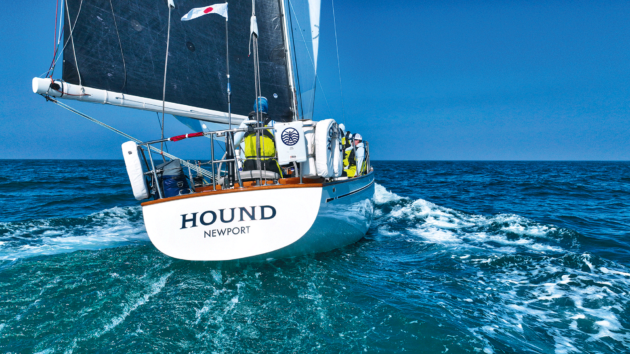Sailing the Transatlantic Race on the iconic 1970s sloop Hound was a tonic for Conrad Humphreys
It’s early morning on 25 June, and last night was tough. The wind peaked at 32 knots and up on deck the mood was a little sombre. Down in the galley area was the A4 gennaker, soaking wet after being recovered from the sea.
The heavy air sail had burst its zippers before it was on the halyard lock, filling prematurely and loading the halyard. As the on-watch crew tried to winch it up the final metre, the halyard snapped. After I’d shouted for assistance, the soggy sail was recovered back on board, but was in two pieces.

Modern sails and classic lines make Hound a fast all-rounder. Photo: Nicholas Horbaczewski
I ran the tapes to see if it was repairable, but sadly the A4 was done. I glanced at the nav computer, we needed that sail to stay with the fleet riding the slow-moving front on the longer easterly route. Without it, we’d fall off the front and into the light winds behind it. We needed a revised strategy.
Ed Cesare and I share the navigating duties on Hound, a beautiful 1970s Aage Nielsen sloop. Built by the renowned Abeking-Rasmussen shipyard, Hound is a poster child for a bygone era of yacht design with her varnished toerails and elegant overhangs.
Sailing the Transatlantic Race: Race-winning upgrades
Hound is owned and skippered by Dan Litchfield, who acquired the yacht in 2020. Together with Tom Stark, Hound’s boat captain, he has overseen a series of race-winning upgrades, including a new, taller carbon mast, a bowsprit and a new North Sail inventory that looks to exploit some of the gaps in her performance polar.
Not just the prettiest boat on the dock, Hound’s classic design now masks an exceptional all-round performance, with no notable performance weakness despite her 25 ton displacement.

Silky smooth sailing and dolphins for company. Photo: Nicholas Horbaczewski
Mid-Atlantic, we quickly ran a new route on Expedition with the latest ECMWF model forecast and it showed the northern route was just a few hours slower than the eastern option. It would put us closer to the ‘great circle’ route and keep us in the stronger north-westerly winds behind the front.
After the A4 sail damage, a noticeably shaken watch had hoisted the jib-top and we were now reaching into an increasingly building sea state. As our watch came back on deck, the decision was already made to put the smaller fractional A3 gennaker up and get ripping along again.
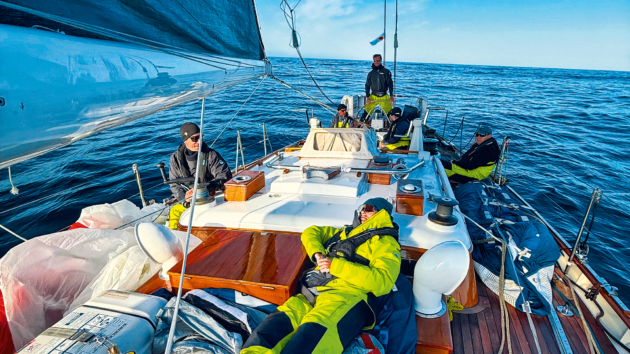
A chance to relax in light airs. Photo: Nicholas Horbaczewski
It’s never an easy decision to split from the fleet, but all three of the yachts ahead of us in our class were lighter, more powerful downwind flyers and would likely stay ahead of the front in fresh south-westerly winds. Ed and I thought it unlikely we could keep up and, once that was clear, Dan made the quick decision to back ourselves on the northern route.
Article continues below…
Dodging windmillls
The RORC Transatlantic Race takes the fleet from Newport, Rhode Island, to Cowes, UK – a month before the centenary edition of the Rolex Fastnet Race (for which I would also be navigating on Hound).
The Transatlantic started at 1300 EDT on 18 June with the line shrouded in thick fog. It was just possible to make out the Castle Hill lighthouse, which marked one end. We had a great start and spent the first night sailing right through the middle of the partially constructed Vineyard Wind Farm (the first commercial wind farm in the US).
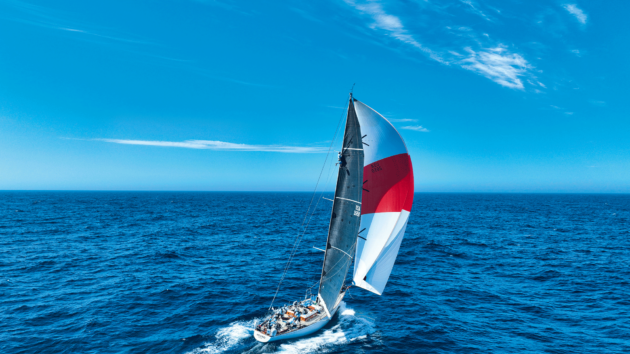
Hound didn’t win the RORC Transatlantic Race, but Conrad Humphreys still found the adventure was an enlightening experience. Photo: Nicholas Horbaczewski
We weren’t the only ones to sail right through the middle of the farm, and I soon heard another former Global Challenge skipper and great friend Dee Caffari on the radio, talking to the wind farm operator, who seemed bemused as to why we’d knowingly sail through a wind farm in thick fog.
Like Dee, we had sight on both radar and AIS of the 62 giant turbines that were spaced one mile apart. Unknown to both of us was the fact that many were not yet in operation and not on AIS!
Once safely through we set about crossing the Nantucket Shoals, where the first of two waypoints were set to keep us to the south of the North Atlantic Right Whale area of conservation – an initiative where science is increasingly being used to help keep sailing boats away from sensitive whaling conservation zones.
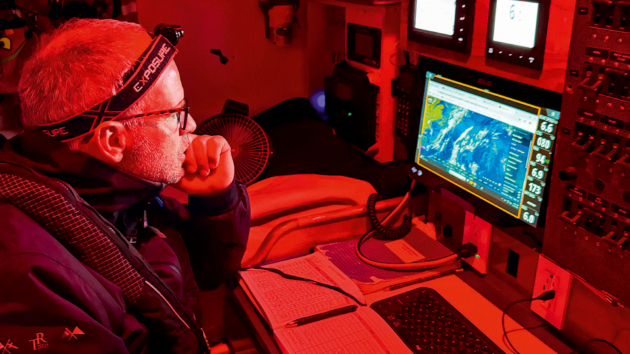
Humphreys studies the weather. Photo: Nicholas Horbaczewski
From Nantucket, we began a 1,200-mile drag race to the southern ice limit waypoint Alpha. Having watched fellow IRC competitor Moana extend a little in the early stages of the leg, sailing in the north with better pressure closer to the ice limit, we opted to also leave any favourable Gulf Stream early and look for better pressure.
As the high pressure took hold, Moana and the two other class leaders (Haspa Hamburg and Ikigai) found themselves in the centre of the high, so we made some really good gains around the outside with a track along the ice limit. By the time we reached Point Alpha we were back leading our class in IRC.
Route choices
On Hound, we sail with two watches, with Ed and I sharing the navigation duties. Using Starlink, we can grab regular GRIB weather files (ECMWF and GFS global models), satellite imagery, synoptic charts and some local observations (normally from buoys or other ships) We would then run the models using Expedition and colour code our routes, before spending time doing some analysis, based on our actual observed conditions.
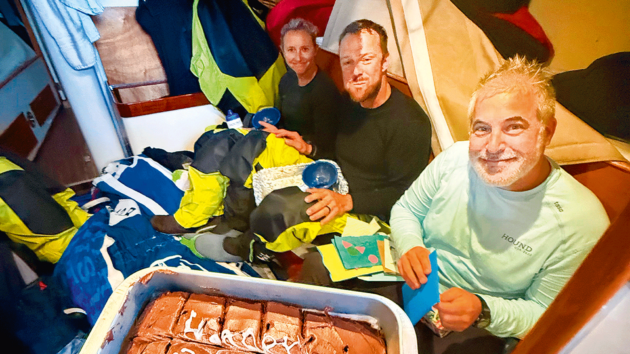
Straight from the oven. Photo: Nicholas Horbaczewski
We’d also run some routes for our competitors, which are tracked via Yellowbrick. At Point Alpha there was a nice jet of Gulf Stream current running to the north-east (up to 2.5 knots), but after that the routeing suggested we continue sailing eastward just ahead of a cold front, rather than the more typical great circle course to the north-east.
There was a danger with following that route, that unless we could maintain high averages, we might fall off the back of the front.
Ed and I considered that if we couldn’t maintain high speeds, we might be better gybing back onto port towards the rhumb line, so we ‘forced’ the routeing with an extra mark on the great circle course – the delta was only three hours, which didn’t seem a lot, considering there was a risk that if we dropped off the front, we’d be forced to gybe north in much lighter winds.
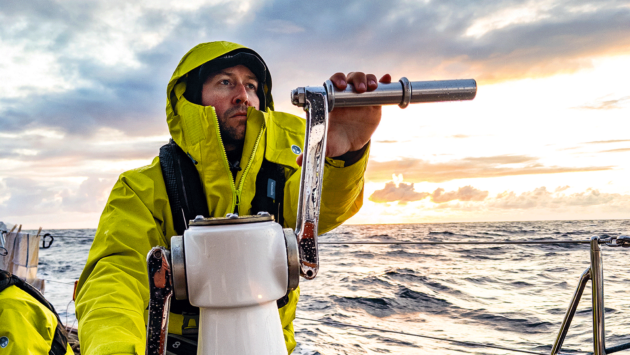
Original 1970s coffee grinder is still in use. Photo: Nicholas Horbaczewski
Splitting from the fleet was not a decision I wanted to take, albeit we were the slowest of our class and the most likely to drop off the front first.
We agreed to push on with our eastward trajectory and look at the next weather update in six hours’ time. The breeze was steady at 20-25 knots and the on-watch decided to set the A4 gennaker. It was moments later that we were back on deck fishing the sail out of the water.
For the first few days, confidence built in our revised strategy. With the A3 we were quick and, while the sea state was challenging, we found a mode that was fast. However, our friends in the east were also making good speeds, pointing their bows directly at the UK. We could only hope that the front would overhaul them.
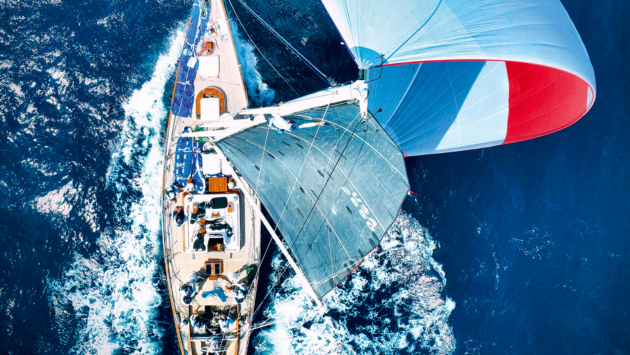
Modern sails and classic lines make Hound a fast all-rounder. Photo: Nicholas Horbaczewski
Last chance
Twenty-four hours later our speed slowed as the low pressure moved away and high pressure moved in. A powerful secondary low formed on the trailing edge of the front and this was the killer blow.
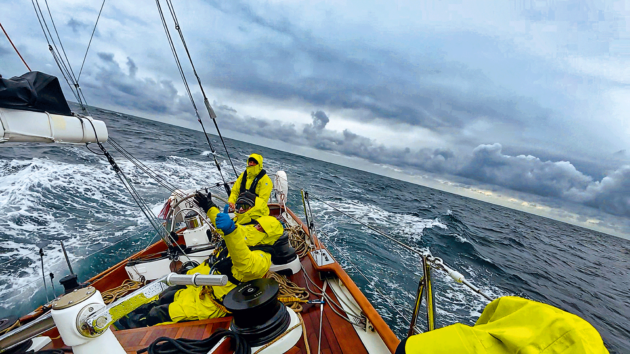
Fresh Atlantic sailing. Photo: Nicholas Horbaczewski
It provided a welcome slingshot for the eastern pack, allowing them to sail fast downwind almost all the way to the western approaches. We faced some headwinds on the northern side of the low, but were too far away to pass under it. This was sadly the nail in our coffin. We could only watch as Moana, Haspa Hamburg and Ikigai disappeared over the horizon and we were left languishing.
What did surprise me, however, was that despite these light downwind conditions Hound was still making good speed. We had a few hours where the wind shut down completely, but in 6 knots of wind we could sail very deep at 130-150° TWA with 7 knots boatspeed. Which, for a 25-tonne yacht, was impressive!
The sailing was silky smooth and we experienced some of the best sunrises and sunsets of the trip. We were also treated to an awesome display of wildlife with numerous whale and dolphin sightings.
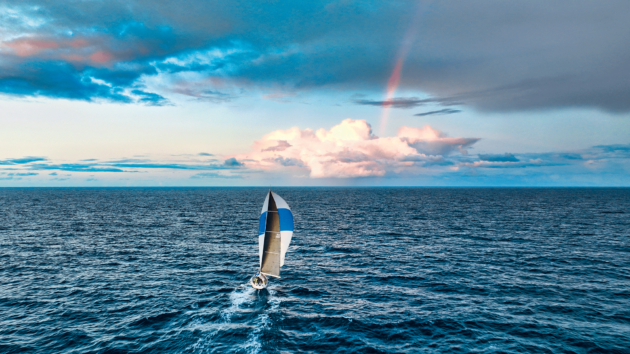
Drone shot as Hound heads into a sunset. Photo: Nicholas Horbaczewski
It was magical sailing and I think we learned a lot about the boat’s performance during that final week that would prove invaluable for the Rolex Fastnet Race later in July.
As we closed in on the Isles of Scilly, we got our first glimpses of the infamous Bishop Rock Lighthouse and the low lying island of St Agnes. From there we passed Wolf Rock and finally closed in on the Lizard, passing it on 4 July, to mark our official time for crossing the Atlantic.
From the Lizard to Start Point is my back garden, having spent many wonderful training sessions between Plymouth, Lizard and Start Point as I prepared for the Vendée Globe. Plymouth has been home since 1994, so I always feel a great sense of nostalgia arriving back into these waters. Luckily for me, the wind lifted us into the bay, so we passed within a mile of Eddystone Lighthouse.
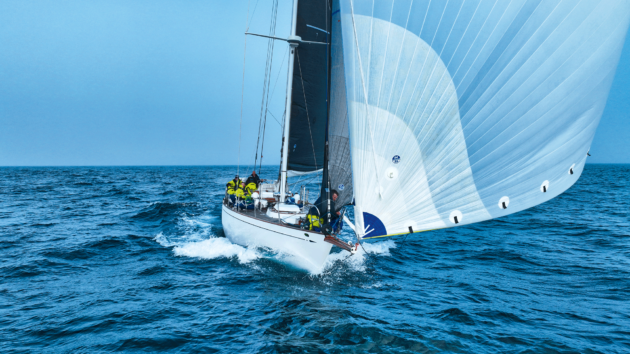
Carbon mast and a bowsprit mean Hound can carry more sail area. Photo: Nicholas Horbaczewski
Raiding party
We gybed back onto starboard as the wind continued to back around to the south-west and build. We peeled to the A2 gennaker off Start Point and Tom appeared with the customs flags, a yellow for ‘Q’ and the Red Ensign. Moments later, a large grey Border Control vessel passed by, I guessed en route to Plymouth.
But they paused behind us and then proceeded to launch their RIB, which was aimed straight at our stern wake.
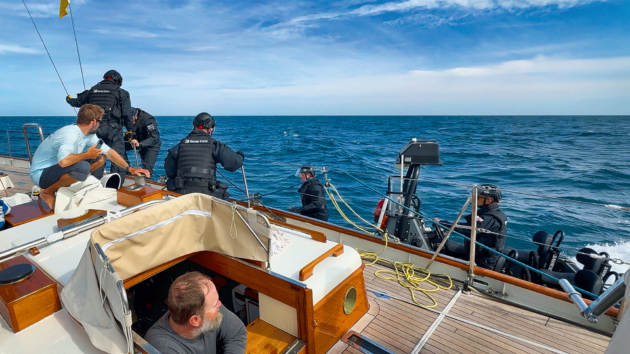
UK Border Force officers climb aboard Hound. Photo: Nicholas Horbaczewski
I called them up on the radio to ask what their intentions were and to see how we might assist, but before I had a chance to finish the call, they’d rammed the RIB alongside and four border control officers hauled themselves on deck.
They then searched the vessel while the person in charge asked a series of questions as to what we were carrying. I was quite surprised – boarding a yacht while racing under spinnaker at speeds of over 10 knots was dangerous and unnecessary.
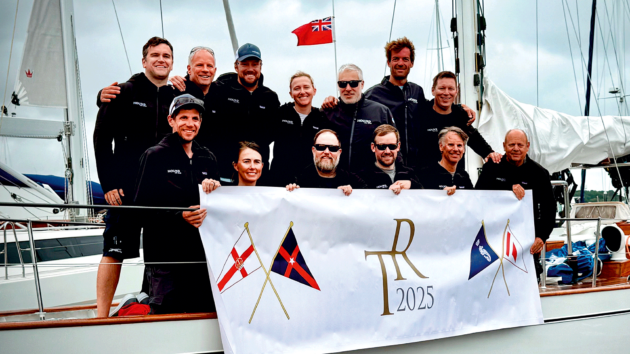
Hound’s RORC Transatlantic Race crew. Photo: Nicholas Horbaczewski
A quick search online would have identified the boat, the American flag and the fact that were racing in the Transatlantic Race. We were also flying a Q flag, which should have indicated we were complying with Customs regulations. Then, having established our credentials they left via the high side of the yacht, almost causing an incident with one of their own team. I was left pretty flabbergasted after the raiding party left.
The final run up the Channel was great fun, with winds of 20 knots from the south-west, we gybed in towards Portland Bill and then picked up a favourable wind shift to lay the Needles.
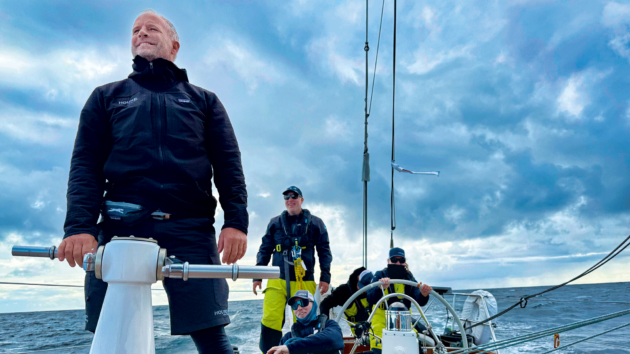
Humphreys takes his turn on the coffee grinder. Photo: Nicholas Horbaczewski
By this point it was dark, so my American team mates weren’t able to see the famous rock formation at the entrance to the Solent, but I could sense their excitement as we swept past Hurst Castle with the flood tide and finally crossed the line off Cowes to finish the Transatlantic Race in an elapsed time of 16d 08h 49mins.
Overall, this was one of my best transatlantic crossings. Hound proved herself a wonderful yacht to race. The sunsets, the wildlife, the banter and the exquisite food made for a fine adventure and I was looking forward to our next race in July, the Rolex Fastnet Race.
 If you enjoyed this….
If you enjoyed this….
Yachting World is the world’s leading magazine for bluewater cruisers and offshore sailors. Every month we have inspirational adventures and practical features to help you realise your sailing dreams.Build your knowledge with a subscription delivered to your door. See our latest offers and save at least 30% off the cover price.
Note: We may earn a commission when you buy through links on our site, at no extra cost to you. This doesn’t affect our editorial independence.




